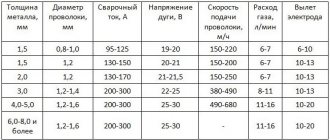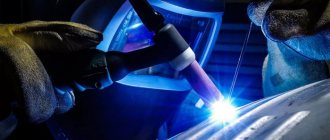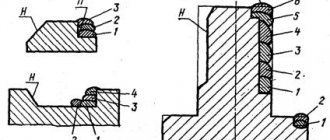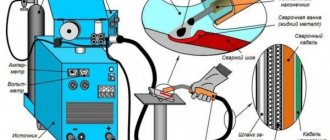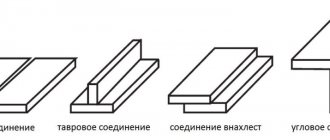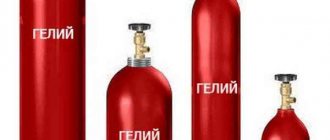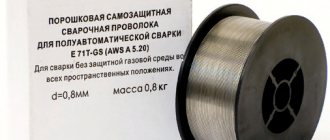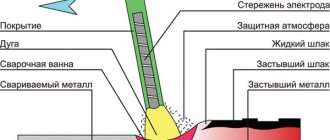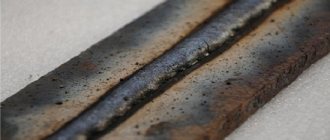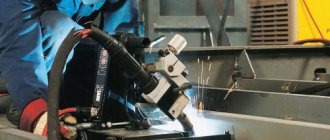The most popular technology today for creating a permanent connection between two metal parts is welding. Not a single production or industrial enterprise can do without it. Depending on the materials and devices used, there are many classifications and varieties of this technology. Let's consider some of the most popular methods - manual and mechanized argon-arc welding with a non-consumable electrode.
What is argon welding
The method of joining two metal parts, which is realized through the formation of an electric arc and the use of additional gas - argon, is called argon-arc welding. The whole process occurs due to the fact that the arc provides a high temperature, melts the metal of the work piece and a special filler rod, thereby forming a weld. Argon, in turn, acts as an insulator and protects the molten metal mass in the weld pool from oxidation. If oxygen or any other gas from the external environment falls there, oxidation occurs, which negatively affects the quality of the solder. Some metals may react and ignite. Argon has chemical qualities that prevent oxygen from combining with the metal. Gas from the apparatus is supplied to the working environment even before ignition and initiation of the arc and continues to be retained for some time after the process has been verified.
Argon welding can be done in two ways:
- a consumable electrode, which is used for ignition and at the same time serves as a soldering material. That is, the conductor melts and provides mass for the formation of a seam. This occurs due to the composition of its coating. You can read more about the electrode method here.
- a non-consumable electrode in which the conductor itself is made of tungsten - a material that is very difficult to melt, even under the influence of high temperatures. During operation, the temperature of the environment is about 2000 degrees, and for melting tungsten requires at least 3600 degrees. Such a rod is used exclusively for arson and creating an arc. Additional material, which is solder, is manually supplied separately.
Fusion in an argon environment is implemented using two technologies:
- TIG – manual argon arc welding with a non-consumable electrode;
- MIG – automatic argon arc welding with a non-consumable electrode.
These techniques can be used both in the household, since they are the simplest, and in production. But for more professional brewing, other, high-precision technologies are used.
Types of non-consumable electrodes
Non-consumable electrodes are used for arc welding of metal structures. This is a consumable material for welding work, which does not have a metallic nature and properties inherent in metals. A similar method of welding operations was invented a long time ago by the hands of N. N. Benardos.
Types of welding electrodes.
Today, when making connections to metal structures, three main types of non-consumable rods are used:
- A carbon non-consumable electrode is actively used in air-arc cutting of metals in order to eliminate various types of defects from the surface of products. In this case, welding must be carried out at currents of no more than 580 Amps. Also, such welding consumables are used to create connections between metal parts in thin-walled structures made of steel and non-ferrous metals. Carbon welding electrodes can be round or flat, folded along the weld line or fed into the weld pool. They can be used with or without an additive, which is determined by the welding technology.
- Graphite rods are relevant for welding non-ferrous metals, as well as their alloys. But they are especially often used when working with copper wires. Graphite consumables are affordable and quite common on the domestic market, as they are characterized by a number of undeniable advantages. Among them: low wear, high temperature resistance, excellent machinability.
- A tungsten welding electrode is made in the form of a rod with a diameter of 1-4 mm and is most often used in production and everyday life. This consumable material is characterized by high refractoriness, that is, it melts at higher temperatures than other types of rods. It allows you to weld a variety of metals without the use of gas protection. Although it is quite possible to carry out welding with a tungsten electrode under such conditions, if necessary. Depending on the composition, products are divided into several groups: lanthanated, ytriated, thoriated, standard.
On a note! Tungsten electrodes with the addition of thorium are radioactive. Despite the fact that this figure is small, they have ceased to be used at large industrial enterprises.
All described types of electrodes for welding work are classified as non-consumable, since during welding work the rod either does not melt at all or melts insignificantly.
In any scenario, the material of the rod is practically not involved in the process of formation of the deposited metal and welded joint.
Welding machine
Arc welding in shielding gas with a non-consumable electrode is carried out using special equipment - a welding machine. It consists of the following elements:
- gas installation ensuring timely and uniform supply of argon;
- power source, which is divided into two types - inverters and transformers.
- wire feed mechanism, which acts as solder;
- burner;
- additional components.
As for power supplies, inverters are more in demand than transformers. This is due to the fact that they can operate in both direct and alternating current modes. The inverter is used in any industrial or home environment. They operate from a regular 220V electrical outlet. When working in an argon environment, voltage drops are extremely undesirable, so cooking with an inverter is much better, better and faster than with a transformer.
The burner is the main part that must be present for this method of fastening parts. Its design may be different, since slightly different parts are used for tungsten soldering and consumable conductor welding. The torch tip (nozzle) is responsible for a number of parameters, the main one of which is the supply of protective gas during the soldering process. Its speed depends on the diameter of the nozzle; the smaller it is, the stronger the feed. Most often, it is made of ceramic so as not to melt or deform under the influence of high temperatures in the working environment.
The gas cylinder can be of any volume, and the frequency of arc interruptions for refueling depends on this.
In addition to the welding machine, you will need personal protective equipment for work - gloves, a robe and a mask, which is needed to protect your eyes from ultraviolet burns.
Additional materials
Gas shielded arc welding with a non-consumable electrode requires, in addition to the main apparatus, additional accessories. Let's look at the most necessary ones:
- filler rods made of various materials are suitable for creating high-quality welds on various metals - non-ferrous, steel, stainless, etc. There are corresponding rods for products made of different metals - aluminum, stainless steel, cast iron, copper and many others. They serve as additional material that acts as solder. That is, the non-consumable conductor provides the welding arc and high temperature, and the rod melts to create the path. Filler rods are used in manual arc welding with a non-consumable electrode in shielding gases. Examples of using rods for different types of alloys can be seen in the table:
- wire is an additional material that is used as solder for automatic argon arc welding with non-consumable electrodes. It is fed in a mechanized mode from a reel installed in the welding machine. Just like rods, wire is made from different materials for use on different metals.
- gas is the main consumable. Mechanized argon arc welding with a consumable conductor or wire cannot be done without an inert gas, which performs the main protective function. Instead of argon, due to its high cost, sometimes welders replace it with helium or carbon dioxide. Its composition is determined by the type of metal that is to be welded. Cylinders come in different capacities, 5, 10, 20, 40 liters and so on. The volume of gas in the cylinder depends on the pressure. For example, in a 10-liter cylinder at a pressure of 150 atm there are 10x150 = 1500 liters of argon (1 atm).
- additional accessories are hoses, fittings and other parts necessary for work. They tend to wear out and therefore require periodic replacement. When choosing the length of the hose, we recommend the space between the installed device and the work area.
All of the above materials must be purchased in accordance with the quality of the metal and the place of work. It is necessary to carefully monitor the serviceability and suitability of each of them. These add-ons are an indispensable and important part of the workflow.
Manual TIG welding
Handling the burner
It is necessary to keep the arc length as short as possible. In practice, the length of the arc is approximately equal to its diameter (Figure 5). If the arc is too long, weld penetration is reduced and the risk of defects due to insufficient penetration, poor weld quality and excessive weld width increases. In addition, air may enter the gas shield cloud of the weld formation area. This will lead to oxide inclusions entering the weld seam.
Figure 5 – Angle of inclination of the torch and welding rod when welding aluminum using the TIG method
The torch must be held as shown in Figure 5 - with an inclination of 80º to the hardened weld. In the case of butt welding of elements of different thicknesses, the arc is directed more towards the thicker element. For fillet welds, the torch is directed in the middle of the angle between two planes.
Filler wire
If filler wire (filler rod) is used, it should be fed evenly and progressively at an angle of 10-20 degrees, as shown in Figure 5. The wire should not be fed directly into the arc, as this can lead to spatter and contamination of the electrode. A rod at an angle of more than 10-20 degrees interferes with visual inspection of the weld pool. The tip of the filler wire must be inside the protective gas cloud as long as it remains hot to avoid oxidation. As the thickness of the component being welded increases, the diameter of the filler wire also increases, which also causes an increase in the arc length. You should always remember that an arc that is too long can cause problems with oxides getting into the weld. Large diameter rod can also obscure the material in front of the weld puddle and interfere with the cleaning action of the arc, which can cause oxides to become trapped in the weld.
Completion of welding
Controlled completion of the weld is very important. Abruptly turning off the welding current can lead to the formation of craters, sink marks (elongated pores) and cracks in the last part of the weld pool. When welding is completed, it is necessary to gradually reduce the welding current and reduce the length of the arc as it fades, adding filler wire until the arc disappears.
Setting parameters for welding
Mechanized fastening of parts with an electrode involves the use of an inert environment to protect the seam from oxidation, which provokes the occurrence of defects. In addition to an even and high-quality seam, the craftsman must carefully ensure that the bathroom does not extend beyond the gas cloud. Thus, the gas is turned on first, and then the ignition and initiation of the arc occurs. This is the most important point. If you do the opposite, the molten metal will mix with oxygen and, due to oxidation, the weld will ultimately turn out to be of poor quality. This is how the work ends. First, the arc is removed, and the gas is supplied for about 10 seconds so that the material crystallizes without oxidation. If possible, it is recommended to supply gas from both sides of the weld to ensure reliable protection. This reduces the risk of reaction with oxygen.
Mechanized argon arc welding with consumable and non-consumable electrodes, settings are made in accordance with the model of the device. As a rule, they are specified in the instructions, or they can be viewed in generally accepted welding tables. With manual technology, the master himself controls the wire feed. It must be held in front of the burner clearly in the direction of the path at a certain angle. This angle depends on the thickness of the seam and the rate of melting of the metal, which, in turn, depends on the type of metal from which the welded products are made.
As for the gas supply mode, this value is unchanged. It is spelled out in GOST tables on the use of various gases for automatic and manual metal welding technology.
The most difficult thing when setting the mode is the current value. It is set and adjusted based on many factors. Firstly, the type of metal plays a big role, for example, thin sheet plates need to be welded at low currents to avoid failure or deformation. Secondly, it is important to consider the type of seam and the location of the parts during operation. When making a vertical weld, the current must be low in order to hold the arc, and at the same time prevent the spreading of the molten metal mass.
It is important for a beginner to take into account that the settings for different types of welding work and materials will be different.
Advantages and disadvantages
This technological process is most widespread when working with non-ferrous metals and alloy steels. It has a number of both advantages and disadvantages. The main advantages include:
- Possibility of minimal deformation in the metals being welded due to the small heating zone;
- High quality of connection due to the use of protective gases that displace oxygen;
- Relatively high speed of work;
- Minimum labor costs for subsequent processing of the seam;
- Relatively wide range of weldable materials.
The main disadvantages are:
- When working outdoors, it is possible to blow shielding gas out of the welding area. To combat this phenomenon, barriers are used or the gas supply is increased, which leads to an increase in its consumption;
- Relatively high-quality preparation of metals before welding;
- Inconvenience when working at an acute angle due to the design features of the burner;
- The need to clean the ignition area outside the welding zone.
Advice from experts
Specialists with many years of experience in welding in inert gases, using consumable and non-consumable conductors, have prepared a number of tips for beginners:
- It is better to supply gas from the other side of the welding track, this will significantly improve the quality, but, however, it will increase consumption;
- to reduce financial costs for additional equipment, you can purchase not pure argon, but a mixture of it with other gases;
- success depends on the number of attempts, so don’t be upset that it doesn’t work out the first time, you need to practice a lot;
- Don’t forget about the correct settings of the device;
- before soldering large products, you need to make a test seam on small workpieces or on an area that is not so important or invisible;
- More precise information on settings for different operating modes can be obtained from the device manufacturer. That is, before use, you must read the instructions and consult a specialist.
The video shows practically what a monolithic connection of parts with rods is and how an even and beautiful seam is made using a non-consumable electrode.
Features of welding aluminum and aluminum alloys
TIG welding of most metals uses direct current of straight polarity. However, these welding conditions are unacceptable when it comes to aluminum and magnesium. This is due to the presence of a strong and refractory oxide film on the surface of these metals. Aluminum is characterized by high chemical activity. It easily interacts with oxygen in the air, i.e. oxidizes. In this case, a thin dense film of aluminum oxide (Al2O3) is formed. Aluminum owes its high corrosion resistance to this film. The melting point of pure aluminum is 660 ºС, and the melting point of aluminum oxide is more than three times higher – 2030 ºС. Aluminum oxide is a ceramic material that is hard and non-conductive. When aluminum melts, it spreads into large droplets kept from merging by an oxide film. If fragments of the film end up in the crystallized weld metal, its mechanical properties will deteriorate. Thus, in order to weld two aluminum parts together, first of all, it is necessary to destroy this oxide film. This can be done:
- mechanically (however, this is practically impossible, since due to the high chemical activity of aluminum it immediately comes into contact with oxygen, and a new layer of aluminum oxide begins to form. Moreover, under conditions of arc welding at high temperatures, aluminum oxidation and the formation of an oxide film happens even more intensely); — chemical treatment (quite difficult and labor-intensive); — welding with reverse polarity; - AC welding.
When connecting the electrode to the negative pole (welding with straight polarity), a significant amount of heat will be transferred to the product, but the film will not be destroyed. If the polarity is changed and the electrode is connected to the positive pole (reverse polarity welding), then less heat will be transferred to the product, however, as soon as the arc is excited, the oxide film will begin to collapse (so-called cathodic cleaning occurs).
There are two theories explaining the mechanism of destruction of the oxide film due to reverse polarity.
The cathode spot, moving along the surface of the weld pool, leads to the evaporation of aluminum oxides, while the emission of electrons from the active cathode spots pushes fragments of the oxide film to the edges of the weld pool, where they form thin strips.
The ion flow has sufficient kinetic energy to destroy the oxide film upon collision with the cathode surface (a similar effect occurs during sandblasting). This theory is supported by the fact that the cleaning effect is higher when using inert gases with a higher atomic weight (argon)
However, along with this positive phenomenon, there will be such negative consequences of welding with reverse polarity as overheating of the electrode, on which too much heat will be generated (causing it to overheat), and low penetration of the base metal. The solution to these problems is AC welding. The combination of forward and reverse polarity allows you to take advantage of both polarities; we obtain the necessary heat input (i.e., penetration of the base metal) in half-periods of direct polarity and cleaning the surface from aluminum oxide (in half-periods of reverse polarity). AC welding at this frequency is the ideal process for joining all types of aluminum and magnesium alloys.
